Quality Tools and Techniques: Six Sigma, Kaizen and Scorecard Analysis
VerifiedAdded on 2020/05/28
|13
|2329
|167
Homework Assignment
AI Summary
This assignment provides a comprehensive analysis of various quality tools and techniques. It begins with an overview of Six Sigma, emphasizing its role in process improvement, cost reduction, and operational streamlining through Lean Six Sigma. The assignment then explores the Kaizen philosophy, detailing its principles and potential pitfalls, as well as providing solutions to these challenges. Further, the document delves into process capability, explaining the Cp and Cpk indices and their significance in assessing process performance. The assignment includes practical examples to illustrate these concepts. It also covers MUDA (waste) in lean manufacturing, quality circles, and the balanced scorecard implementation. The assignment concludes with an application of Gemba and Quality Function Deployment (QFD) for manufacturing processes and calculation of Cp and Cpk values.
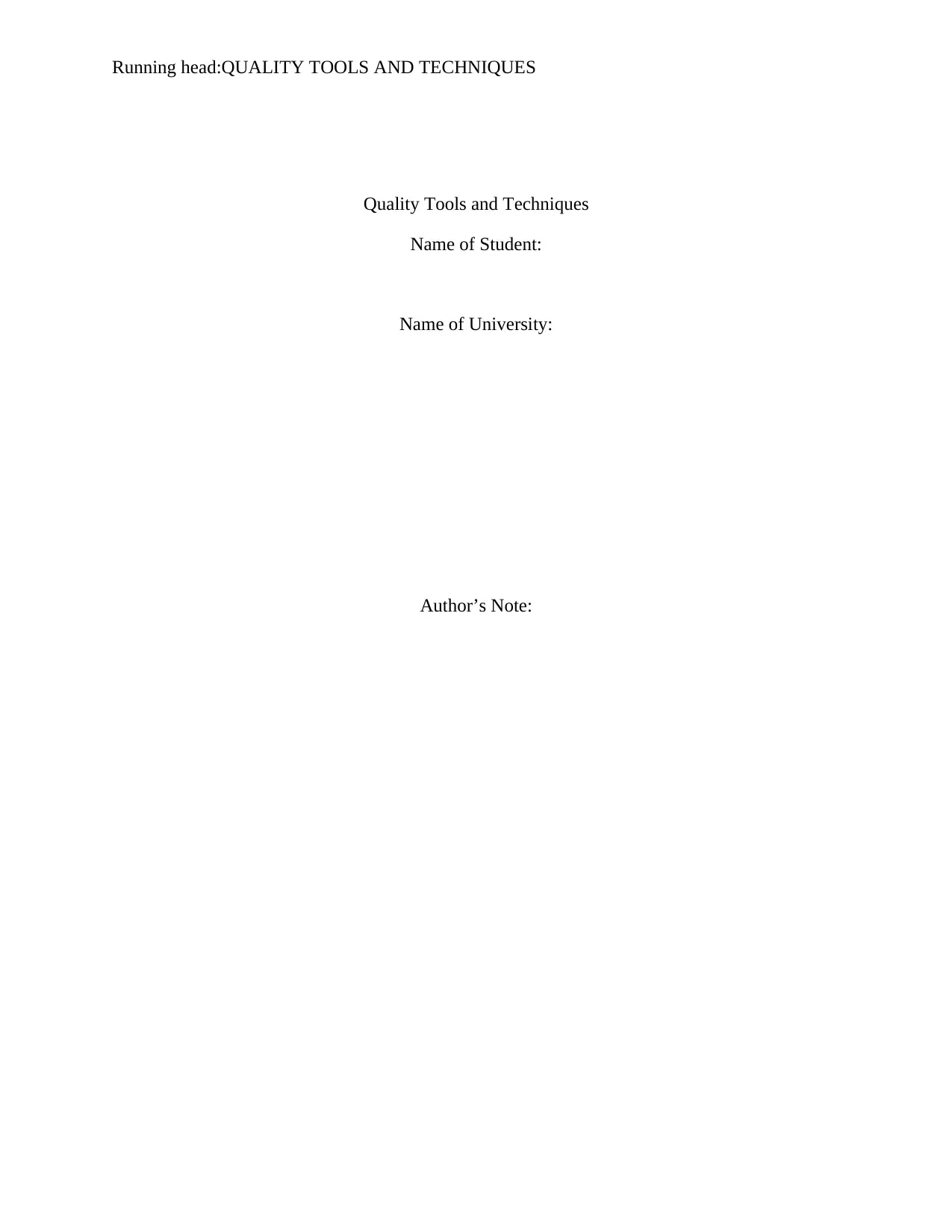
Running head:QUALITY TOOLS AND TECHNIQUES
Quality Tools and Techniques
Name of Student:
Name of University:
Author’s Note:
Quality Tools and Techniques
Name of Student:
Name of University:
Author’s Note:
Paraphrase This Document
Need a fresh take? Get an instant paraphrase of this document with our AI Paraphraser
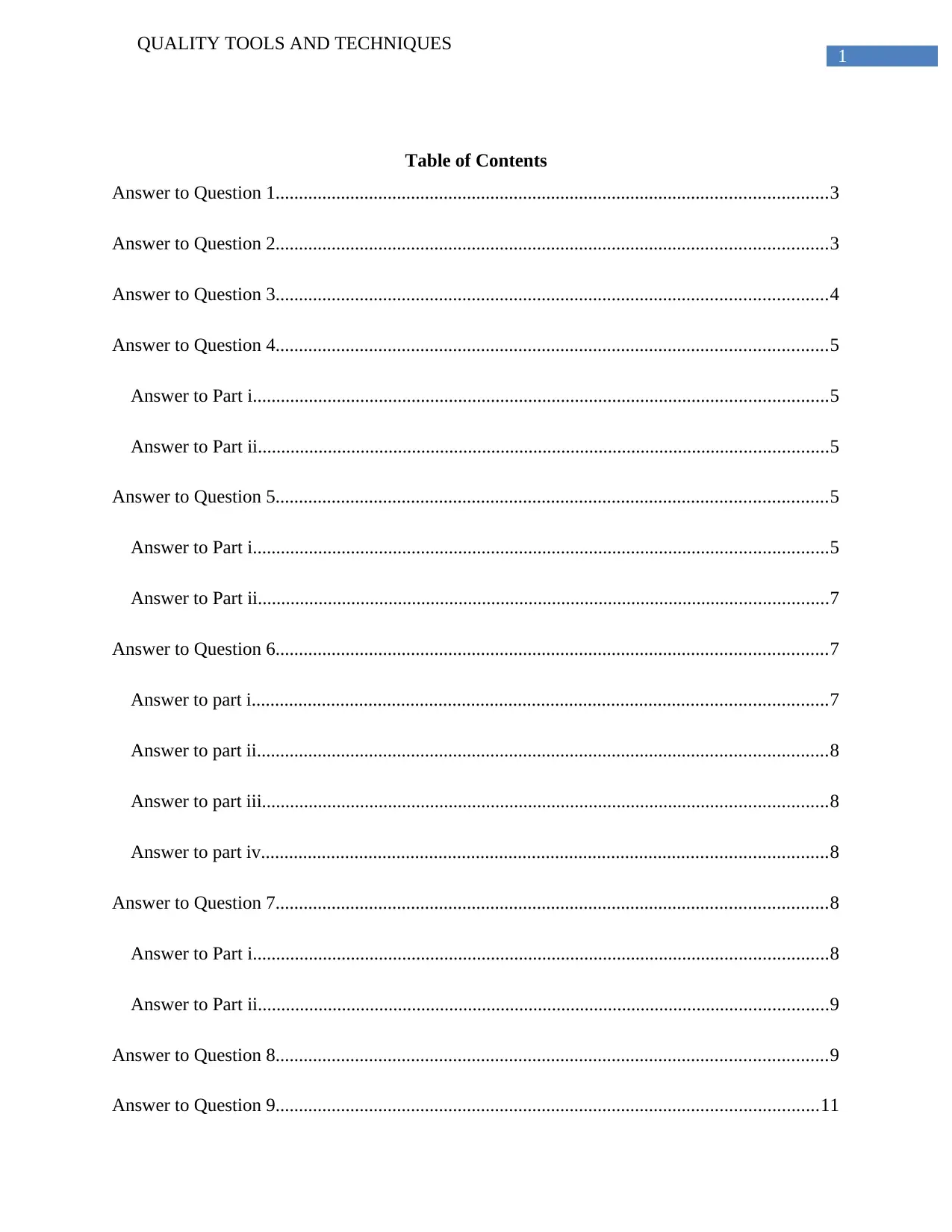
1
QUALITY TOOLS AND TECHNIQUES
Table of Contents
Answer to Question 1......................................................................................................................3
Answer to Question 2......................................................................................................................3
Answer to Question 3......................................................................................................................4
Answer to Question 4......................................................................................................................5
Answer to Part i...........................................................................................................................5
Answer to Part ii..........................................................................................................................5
Answer to Question 5......................................................................................................................5
Answer to Part i...........................................................................................................................5
Answer to Part ii..........................................................................................................................7
Answer to Question 6......................................................................................................................7
Answer to part i...........................................................................................................................7
Answer to part ii..........................................................................................................................8
Answer to part iii.........................................................................................................................8
Answer to part iv.........................................................................................................................8
Answer to Question 7......................................................................................................................8
Answer to Part i...........................................................................................................................8
Answer to Part ii..........................................................................................................................9
Answer to Question 8......................................................................................................................9
Answer to Question 9....................................................................................................................11
QUALITY TOOLS AND TECHNIQUES
Table of Contents
Answer to Question 1......................................................................................................................3
Answer to Question 2......................................................................................................................3
Answer to Question 3......................................................................................................................4
Answer to Question 4......................................................................................................................5
Answer to Part i...........................................................................................................................5
Answer to Part ii..........................................................................................................................5
Answer to Question 5......................................................................................................................5
Answer to Part i...........................................................................................................................5
Answer to Part ii..........................................................................................................................7
Answer to Question 6......................................................................................................................7
Answer to part i...........................................................................................................................7
Answer to part ii..........................................................................................................................8
Answer to part iii.........................................................................................................................8
Answer to part iv.........................................................................................................................8
Answer to Question 7......................................................................................................................8
Answer to Part i...........................................................................................................................8
Answer to Part ii..........................................................................................................................9
Answer to Question 8......................................................................................................................9
Answer to Question 9....................................................................................................................11
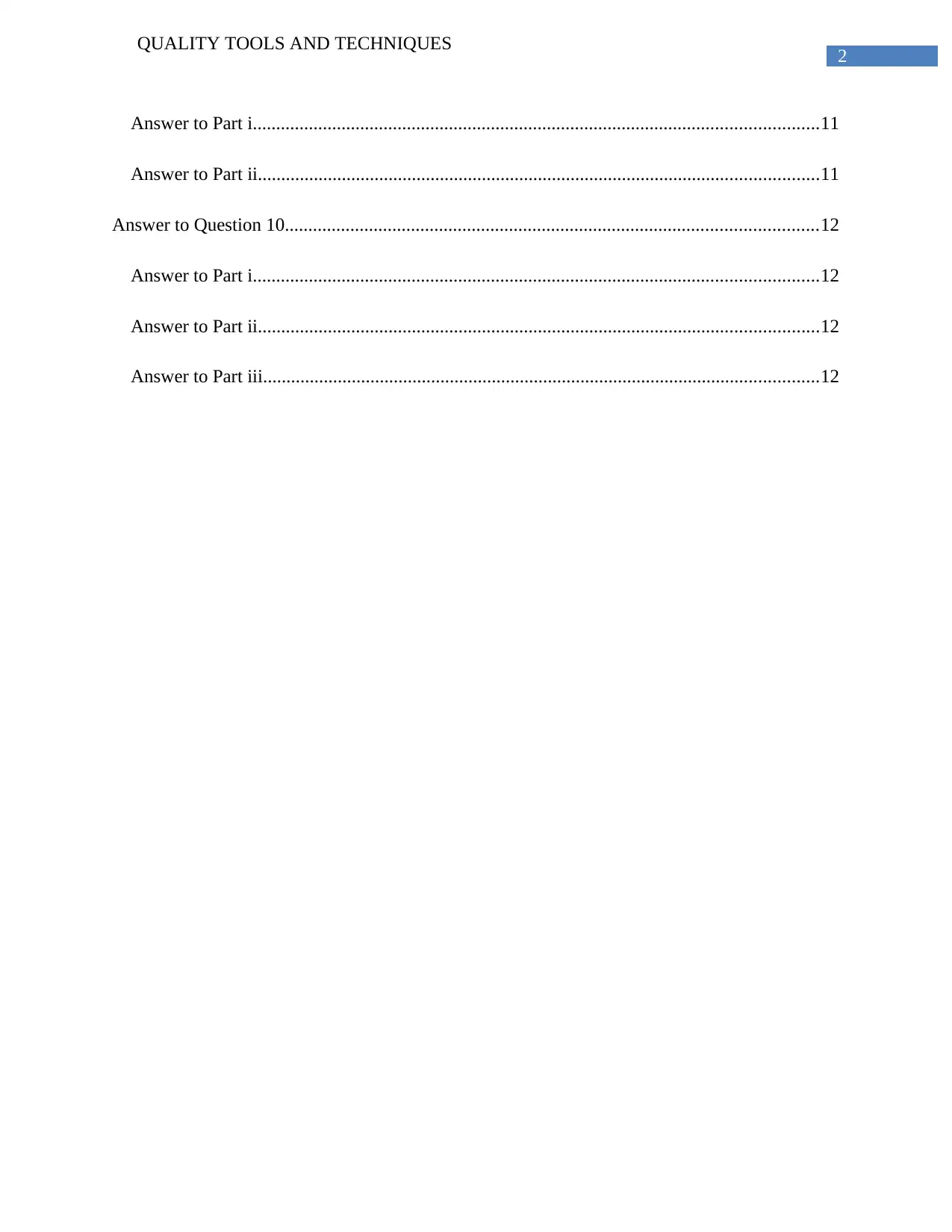
2
QUALITY TOOLS AND TECHNIQUES
Answer to Part i.........................................................................................................................11
Answer to Part ii........................................................................................................................11
Answer to Question 10..................................................................................................................12
Answer to Part i.........................................................................................................................12
Answer to Part ii........................................................................................................................12
Answer to Part iii.......................................................................................................................12
QUALITY TOOLS AND TECHNIQUES
Answer to Part i.........................................................................................................................11
Answer to Part ii........................................................................................................................11
Answer to Question 10..................................................................................................................12
Answer to Part i.........................................................................................................................12
Answer to Part ii........................................................................................................................12
Answer to Part iii.......................................................................................................................12
⊘ This is a preview!⊘
Do you want full access?
Subscribe today to unlock all pages.

Trusted by 1+ million students worldwide
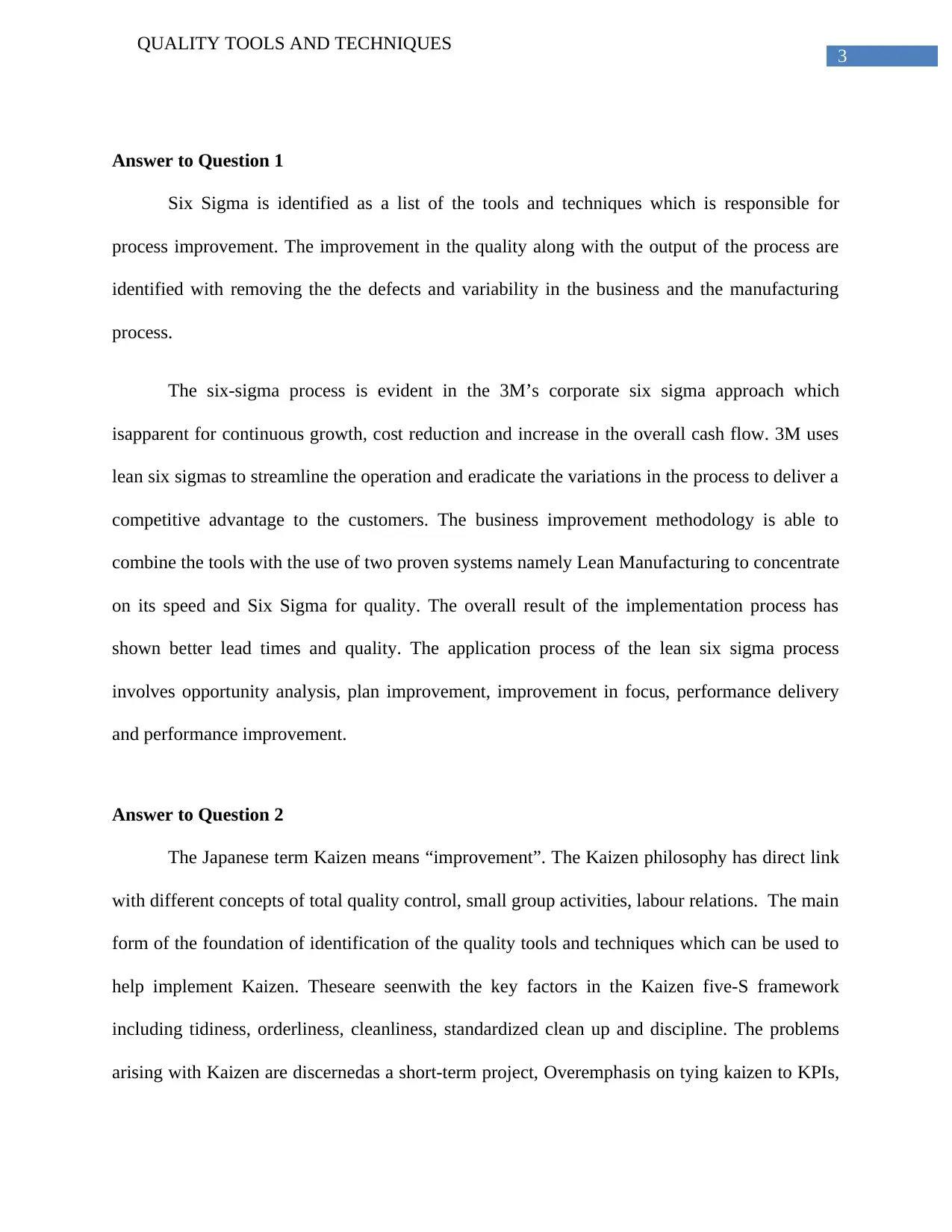
3
QUALITY TOOLS AND TECHNIQUES
Answer to Question 1
Six Sigma is identified as a list of the tools and techniques which is responsible for
process improvement. The improvement in the quality along with the output of the process are
identified with removing the the defects and variability in the business and the manufacturing
process.
The six-sigma process is evident in the 3M’s corporate six sigma approach which
isapparent for continuous growth, cost reduction and increase in the overall cash flow. 3M uses
lean six sigmas to streamline the operation and eradicate the variations in the process to deliver a
competitive advantage to the customers. The business improvement methodology is able to
combine the tools with the use of two proven systems namely Lean Manufacturing to concentrate
on its speed and Six Sigma for quality. The overall result of the implementation process has
shown better lead times and quality. The application process of the lean six sigma process
involves opportunity analysis, plan improvement, improvement in focus, performance delivery
and performance improvement.
Answer to Question 2
The Japanese term Kaizen means “improvement”. The Kaizen philosophy has direct link
with different concepts of total quality control, small group activities, labour relations. The main
form of the foundation of identification of the quality tools and techniques which can be used to
help implement Kaizen. Theseare seenwith the key factors in the Kaizen five-S framework
including tidiness, orderliness, cleanliness, standardized clean up and discipline. The problems
arising with Kaizen are discernedas a short-term project, Overemphasis on tying kaizen to KPIs,
QUALITY TOOLS AND TECHNIQUES
Answer to Question 1
Six Sigma is identified as a list of the tools and techniques which is responsible for
process improvement. The improvement in the quality along with the output of the process are
identified with removing the the defects and variability in the business and the manufacturing
process.
The six-sigma process is evident in the 3M’s corporate six sigma approach which
isapparent for continuous growth, cost reduction and increase in the overall cash flow. 3M uses
lean six sigmas to streamline the operation and eradicate the variations in the process to deliver a
competitive advantage to the customers. The business improvement methodology is able to
combine the tools with the use of two proven systems namely Lean Manufacturing to concentrate
on its speed and Six Sigma for quality. The overall result of the implementation process has
shown better lead times and quality. The application process of the lean six sigma process
involves opportunity analysis, plan improvement, improvement in focus, performance delivery
and performance improvement.
Answer to Question 2
The Japanese term Kaizen means “improvement”. The Kaizen philosophy has direct link
with different concepts of total quality control, small group activities, labour relations. The main
form of the foundation of identification of the quality tools and techniques which can be used to
help implement Kaizen. Theseare seenwith the key factors in the Kaizen five-S framework
including tidiness, orderliness, cleanliness, standardized clean up and discipline. The problems
arising with Kaizen are discernedas a short-term project, Overemphasis on tying kaizen to KPIs,
Paraphrase This Document
Need a fresh take? Get an instant paraphrase of this document with our AI Paraphraser
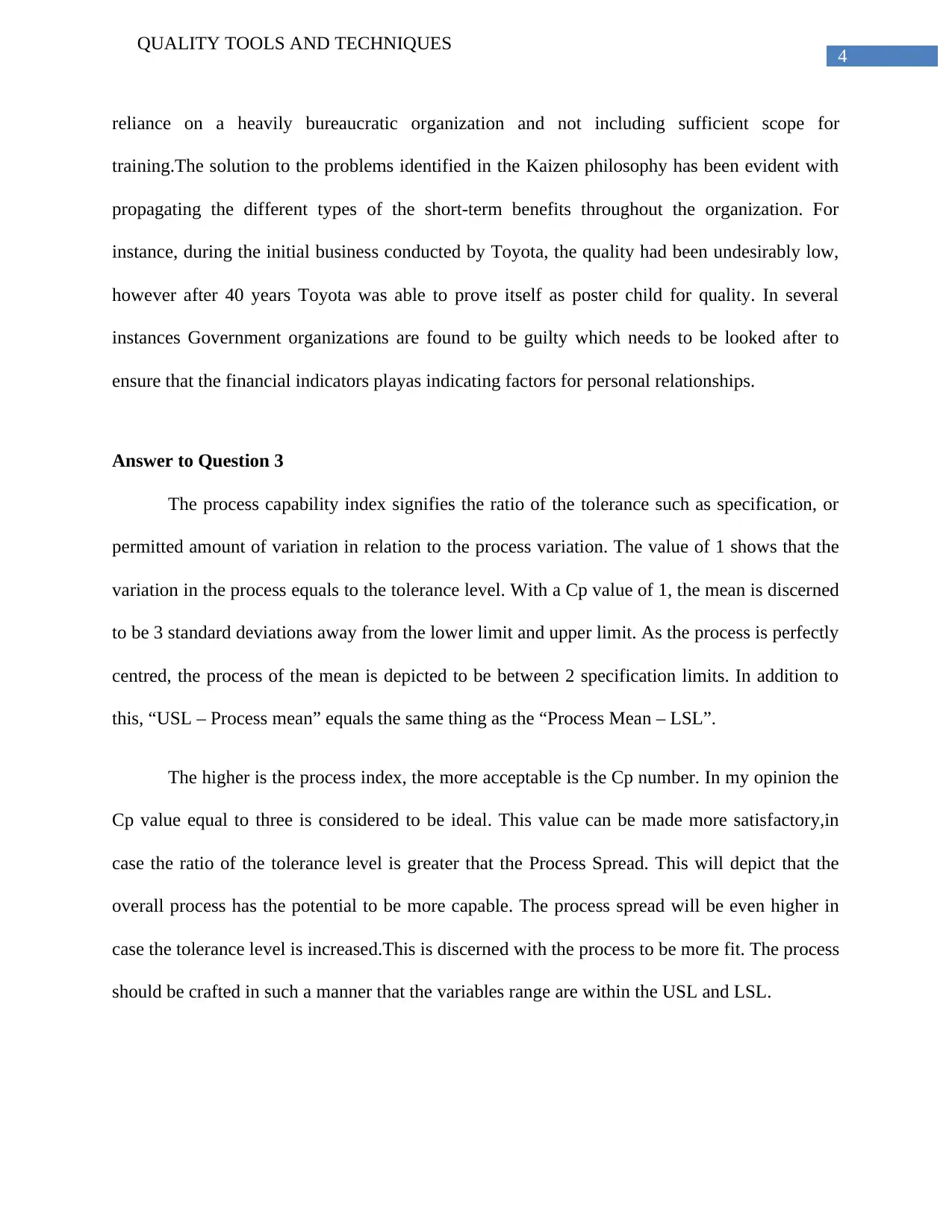
4
QUALITY TOOLS AND TECHNIQUES
reliance on a heavily bureaucratic organization and not including sufficient scope for
training.The solution to the problems identified in the Kaizen philosophy has been evident with
propagating the different types of the short-term benefits throughout the organization. For
instance, during the initial business conducted by Toyota, the quality had been undesirably low,
however after 40 years Toyota was able to prove itself as poster child for quality. In several
instances Government organizations are found to be guilty which needs to be looked after to
ensure that the financial indicators playas indicating factors for personal relationships.
Answer to Question 3
The process capability index signifies the ratio of the tolerance such as specification, or
permitted amount of variation in relation to the process variation. The value of 1 shows that the
variation in the process equals to the tolerance level. With a Cp value of 1, the mean is discerned
to be 3 standard deviations away from the lower limit and upper limit. As the process is perfectly
centred, the process of the mean is depicted to be between 2 specification limits. In addition to
this, “USL – Process mean” equals the same thing as the “Process Mean – LSL”.
The higher is the process index, the more acceptable is the Cp number. In my opinion the
Cp value equal to three is considered to be ideal. This value can be made more satisfactory,in
case the ratio of the tolerance level is greater that the Process Spread. This will depict that the
overall process has the potential to be more capable. The process spread will be even higher in
case the tolerance level is increased.This is discerned with the process to be more fit. The process
should be crafted in such a manner that the variables range are within the USL and LSL.
QUALITY TOOLS AND TECHNIQUES
reliance on a heavily bureaucratic organization and not including sufficient scope for
training.The solution to the problems identified in the Kaizen philosophy has been evident with
propagating the different types of the short-term benefits throughout the organization. For
instance, during the initial business conducted by Toyota, the quality had been undesirably low,
however after 40 years Toyota was able to prove itself as poster child for quality. In several
instances Government organizations are found to be guilty which needs to be looked after to
ensure that the financial indicators playas indicating factors for personal relationships.
Answer to Question 3
The process capability index signifies the ratio of the tolerance such as specification, or
permitted amount of variation in relation to the process variation. The value of 1 shows that the
variation in the process equals to the tolerance level. With a Cp value of 1, the mean is discerned
to be 3 standard deviations away from the lower limit and upper limit. As the process is perfectly
centred, the process of the mean is depicted to be between 2 specification limits. In addition to
this, “USL – Process mean” equals the same thing as the “Process Mean – LSL”.
The higher is the process index, the more acceptable is the Cp number. In my opinion the
Cp value equal to three is considered to be ideal. This value can be made more satisfactory,in
case the ratio of the tolerance level is greater that the Process Spread. This will depict that the
overall process has the potential to be more capable. The process spread will be even higher in
case the tolerance level is increased.This is discerned with the process to be more fit. The process
should be crafted in such a manner that the variables range are within the USL and LSL.
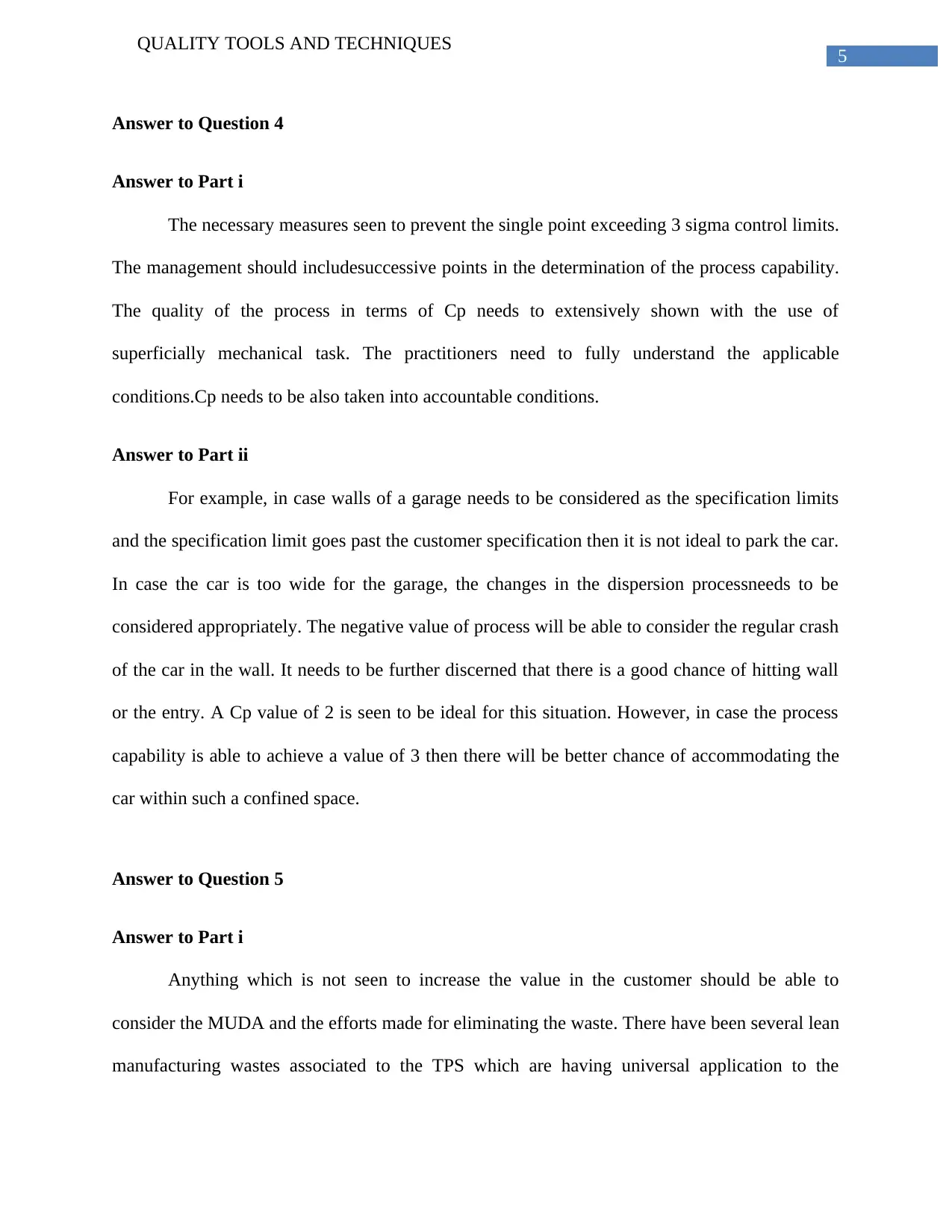
5
QUALITY TOOLS AND TECHNIQUES
Answer to Question 4
Answer to Part i
The necessary measures seen to prevent the single point exceeding 3 sigma control limits.
The management should includesuccessive points in the determination of the process capability.
The quality of the process in terms of Cp needs to extensively shown with the use of
superficially mechanical task. The practitioners need to fully understand the applicable
conditions.Cp needs to be also taken into accountable conditions.
Answer to Part ii
For example, in case walls of a garage needs to be considered as the specification limits
and the specification limit goes past the customer specification then it is not ideal to park the car.
In case the car is too wide for the garage, the changes in the dispersion processneeds to be
considered appropriately. The negative value of process will be able to consider the regular crash
of the car in the wall. It needs to be further discerned that there is a good chance of hitting wall
or the entry. A Cp value of 2 is seen to be ideal for this situation. However, in case the process
capability is able to achieve a value of 3 then there will be better chance of accommodating the
car within such a confined space.
Answer to Question 5
Answer to Part i
Anything which is not seen to increase the value in the customer should be able to
consider the MUDA and the efforts made for eliminating the waste. There have been several lean
manufacturing wastes associated to the TPS which are having universal application to the
QUALITY TOOLS AND TECHNIQUES
Answer to Question 4
Answer to Part i
The necessary measures seen to prevent the single point exceeding 3 sigma control limits.
The management should includesuccessive points in the determination of the process capability.
The quality of the process in terms of Cp needs to extensively shown with the use of
superficially mechanical task. The practitioners need to fully understand the applicable
conditions.Cp needs to be also taken into accountable conditions.
Answer to Part ii
For example, in case walls of a garage needs to be considered as the specification limits
and the specification limit goes past the customer specification then it is not ideal to park the car.
In case the car is too wide for the garage, the changes in the dispersion processneeds to be
considered appropriately. The negative value of process will be able to consider the regular crash
of the car in the wall. It needs to be further discerned that there is a good chance of hitting wall
or the entry. A Cp value of 2 is seen to be ideal for this situation. However, in case the process
capability is able to achieve a value of 3 then there will be better chance of accommodating the
car within such a confined space.
Answer to Question 5
Answer to Part i
Anything which is not seen to increase the value in the customer should be able to
consider the MUDA and the efforts made for eliminating the waste. There have been several lean
manufacturing wastes associated to the TPS which are having universal application to the
⊘ This is a preview!⊘
Do you want full access?
Subscribe today to unlock all pages.

Trusted by 1+ million students worldwide
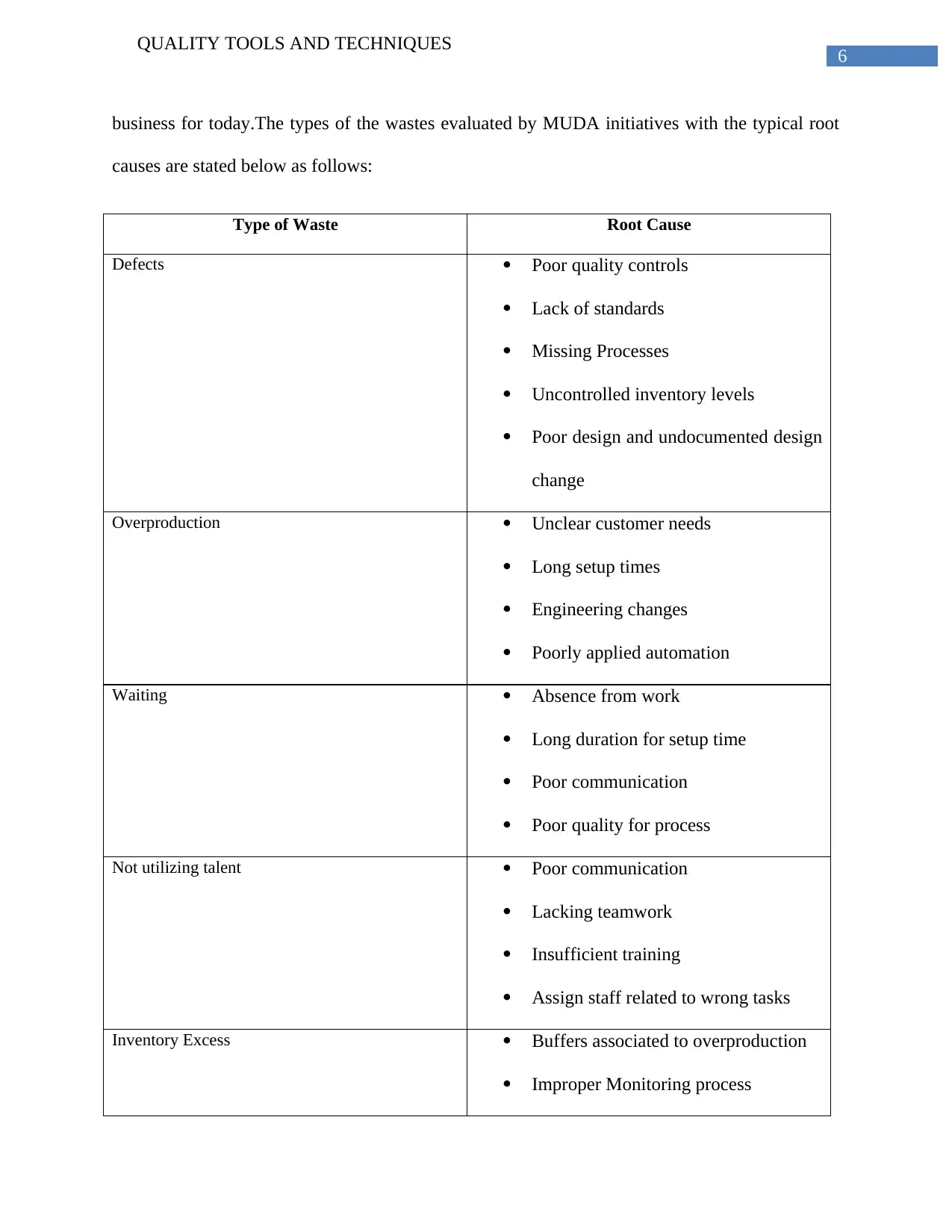
6
QUALITY TOOLS AND TECHNIQUES
business for today.The types of the wastes evaluated by MUDA initiatives with the typical root
causes are stated below as follows:
Type of Waste Root Cause
Defects Poor quality controls
Lack of standards
Missing Processes
Uncontrolled inventory levels
Poor design and undocumented design
change
Overproduction Unclear customer needs
Long setup times
Engineering changes
Poorly applied automation
Waiting Absence from work
Long duration for setup time
Poor communication
Poor quality for process
Not utilizing talent Poor communication
Lacking teamwork
Insufficient training
Assign staff related to wrong tasks
Inventory Excess Buffers associated to overproduction
Improper Monitoring process
QUALITY TOOLS AND TECHNIQUES
business for today.The types of the wastes evaluated by MUDA initiatives with the typical root
causes are stated below as follows:
Type of Waste Root Cause
Defects Poor quality controls
Lack of standards
Missing Processes
Uncontrolled inventory levels
Poor design and undocumented design
change
Overproduction Unclear customer needs
Long setup times
Engineering changes
Poorly applied automation
Waiting Absence from work
Long duration for setup time
Poor communication
Poor quality for process
Not utilizing talent Poor communication
Lacking teamwork
Insufficient training
Assign staff related to wrong tasks
Inventory Excess Buffers associated to overproduction
Improper Monitoring process
Paraphrase This Document
Need a fresh take? Get an instant paraphrase of this document with our AI Paraphraser
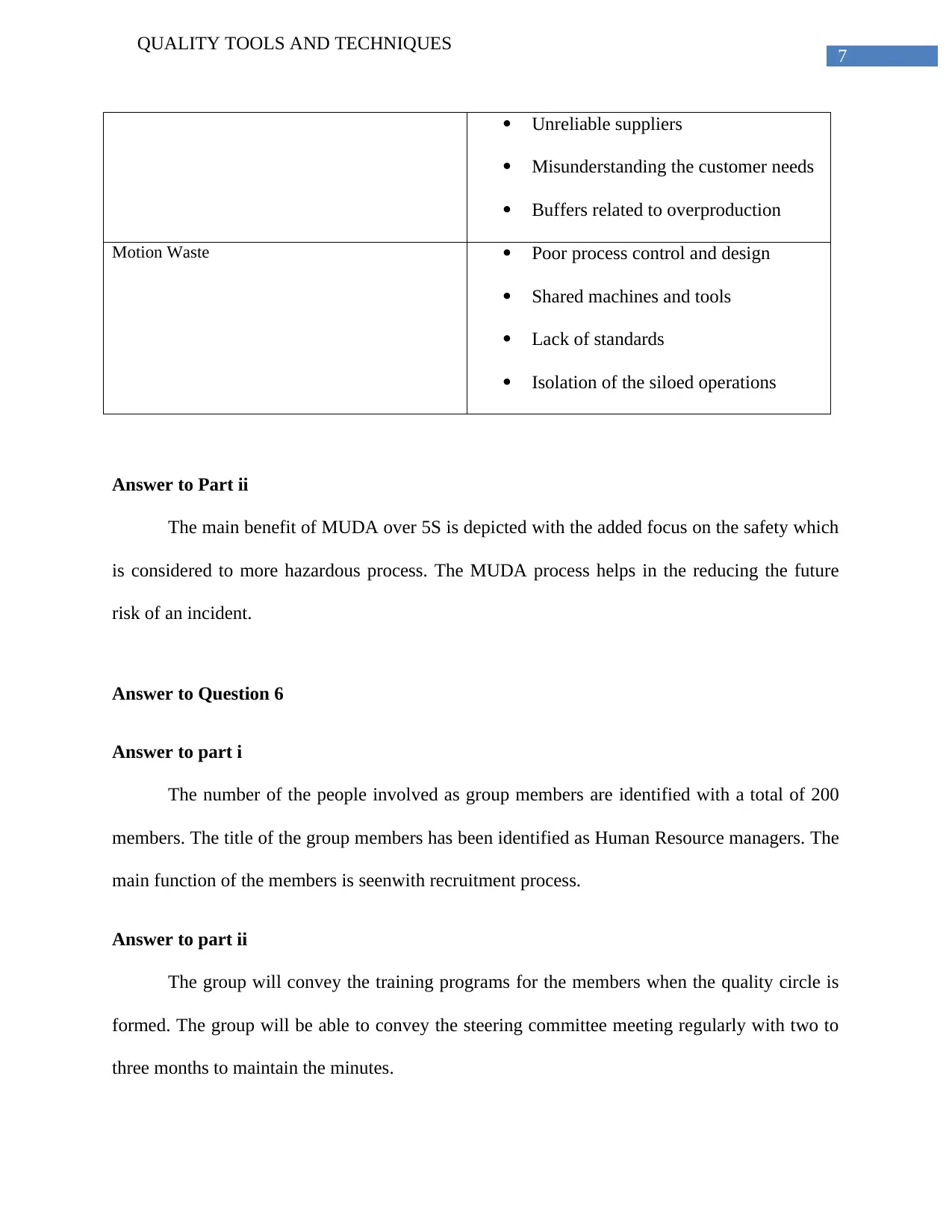
7
QUALITY TOOLS AND TECHNIQUES
Unreliable suppliers
Misunderstanding the customer needs
Buffers related to overproduction
Motion Waste Poor process control and design
Shared machines and tools
Lack of standards
Isolation of the siloed operations
Answer to Part ii
The main benefit of MUDA over 5S is depicted with the added focus on the safety which
is considered to more hazardous process. The MUDA process helps in the reducing the future
risk of an incident.
Answer to Question 6
Answer to part i
The number of the people involved as group members are identified with a total of 200
members. The title of the group members has been identified as Human Resource managers. The
main function of the members is seenwith recruitment process.
Answer to part ii
The group will convey the training programs for the members when the quality circle is
formed. The group will be able to convey the steering committee meeting regularly with two to
three months to maintain the minutes.
QUALITY TOOLS AND TECHNIQUES
Unreliable suppliers
Misunderstanding the customer needs
Buffers related to overproduction
Motion Waste Poor process control and design
Shared machines and tools
Lack of standards
Isolation of the siloed operations
Answer to Part ii
The main benefit of MUDA over 5S is depicted with the added focus on the safety which
is considered to more hazardous process. The MUDA process helps in the reducing the future
risk of an incident.
Answer to Question 6
Answer to part i
The number of the people involved as group members are identified with a total of 200
members. The title of the group members has been identified as Human Resource managers. The
main function of the members is seenwith recruitment process.
Answer to part ii
The group will convey the training programs for the members when the quality circle is
formed. The group will be able to convey the steering committee meeting regularly with two to
three months to maintain the minutes.
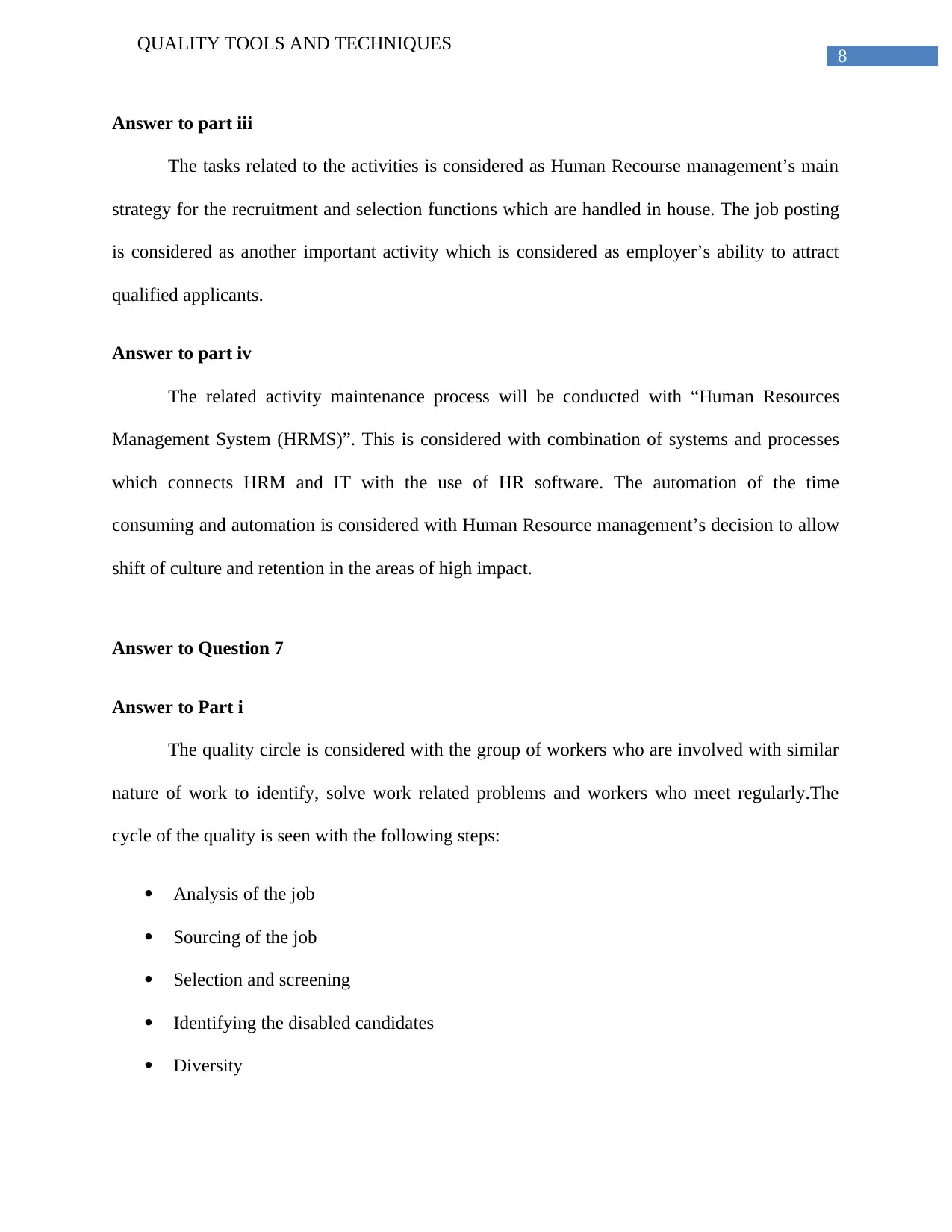
8
QUALITY TOOLS AND TECHNIQUES
Answer to part iii
The tasks related to the activities is considered as Human Recourse management’s main
strategy for the recruitment and selection functions which are handled in house. The job posting
is considered as another important activity which is considered as employer’s ability to attract
qualified applicants.
Answer to part iv
The related activity maintenance process will be conducted with “Human Resources
Management System (HRMS)”. This is considered with combination of systems and processes
which connects HRM and IT with the use of HR software. The automation of the time
consuming and automation is considered with Human Resource management’s decision to allow
shift of culture and retention in the areas of high impact.
Answer to Question 7
Answer to Part i
The quality circle is considered with the group of workers who are involved with similar
nature of work to identify, solve work related problems and workers who meet regularly.The
cycle of the quality is seen with the following steps:
Analysis of the job
Sourcing of the job
Selection and screening
Identifying the disabled candidates
Diversity
QUALITY TOOLS AND TECHNIQUES
Answer to part iii
The tasks related to the activities is considered as Human Recourse management’s main
strategy for the recruitment and selection functions which are handled in house. The job posting
is considered as another important activity which is considered as employer’s ability to attract
qualified applicants.
Answer to part iv
The related activity maintenance process will be conducted with “Human Resources
Management System (HRMS)”. This is considered with combination of systems and processes
which connects HRM and IT with the use of HR software. The automation of the time
consuming and automation is considered with Human Resource management’s decision to allow
shift of culture and retention in the areas of high impact.
Answer to Question 7
Answer to Part i
The quality circle is considered with the group of workers who are involved with similar
nature of work to identify, solve work related problems and workers who meet regularly.The
cycle of the quality is seen with the following steps:
Analysis of the job
Sourcing of the job
Selection and screening
Identifying the disabled candidates
Diversity
⊘ This is a preview!⊘
Do you want full access?
Subscribe today to unlock all pages.

Trusted by 1+ million students worldwide
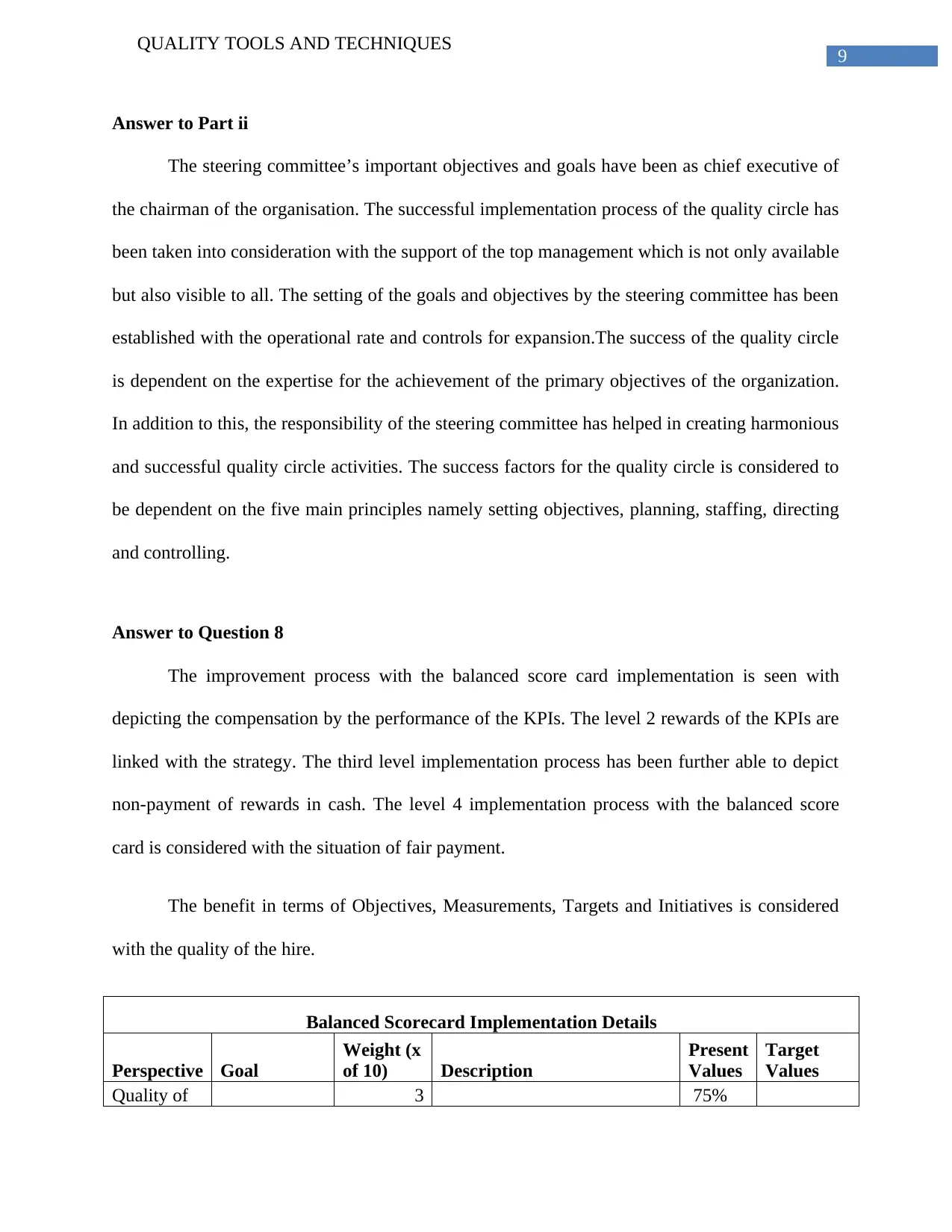
9
QUALITY TOOLS AND TECHNIQUES
Answer to Part ii
The steering committee’s important objectives and goals have been as chief executive of
the chairman of the organisation. The successful implementation process of the quality circle has
been taken into consideration with the support of the top management which is not only available
but also visible to all. The setting of the goals and objectives by the steering committee has been
established with the operational rate and controls for expansion.The success of the quality circle
is dependent on the expertise for the achievement of the primary objectives of the organization.
In addition to this, the responsibility of the steering committee has helped in creating harmonious
and successful quality circle activities. The success factors for the quality circle is considered to
be dependent on the five main principles namely setting objectives, planning, staffing, directing
and controlling.
Answer to Question 8
The improvement process with the balanced score card implementation is seen with
depicting the compensation by the performance of the KPIs. The level 2 rewards of the KPIs are
linked with the strategy. The third level implementation process has been further able to depict
non-payment of rewards in cash. The level 4 implementation process with the balanced score
card is considered with the situation of fair payment.
The benefit in terms of Objectives, Measurements, Targets and Initiatives is considered
with the quality of the hire.
Balanced Scorecard Implementation Details
Perspective Goal
Weight (x
of 10) Description
Present
Values
Target
Values
Quality of 3 75%
QUALITY TOOLS AND TECHNIQUES
Answer to Part ii
The steering committee’s important objectives and goals have been as chief executive of
the chairman of the organisation. The successful implementation process of the quality circle has
been taken into consideration with the support of the top management which is not only available
but also visible to all. The setting of the goals and objectives by the steering committee has been
established with the operational rate and controls for expansion.The success of the quality circle
is dependent on the expertise for the achievement of the primary objectives of the organization.
In addition to this, the responsibility of the steering committee has helped in creating harmonious
and successful quality circle activities. The success factors for the quality circle is considered to
be dependent on the five main principles namely setting objectives, planning, staffing, directing
and controlling.
Answer to Question 8
The improvement process with the balanced score card implementation is seen with
depicting the compensation by the performance of the KPIs. The level 2 rewards of the KPIs are
linked with the strategy. The third level implementation process has been further able to depict
non-payment of rewards in cash. The level 4 implementation process with the balanced score
card is considered with the situation of fair payment.
The benefit in terms of Objectives, Measurements, Targets and Initiatives is considered
with the quality of the hire.
Balanced Scorecard Implementation Details
Perspective Goal
Weight (x
of 10) Description
Present
Values
Target
Values
Quality of 3 75%
Paraphrase This Document
Need a fresh take? Get an instant paraphrase of this document with our AI Paraphraser
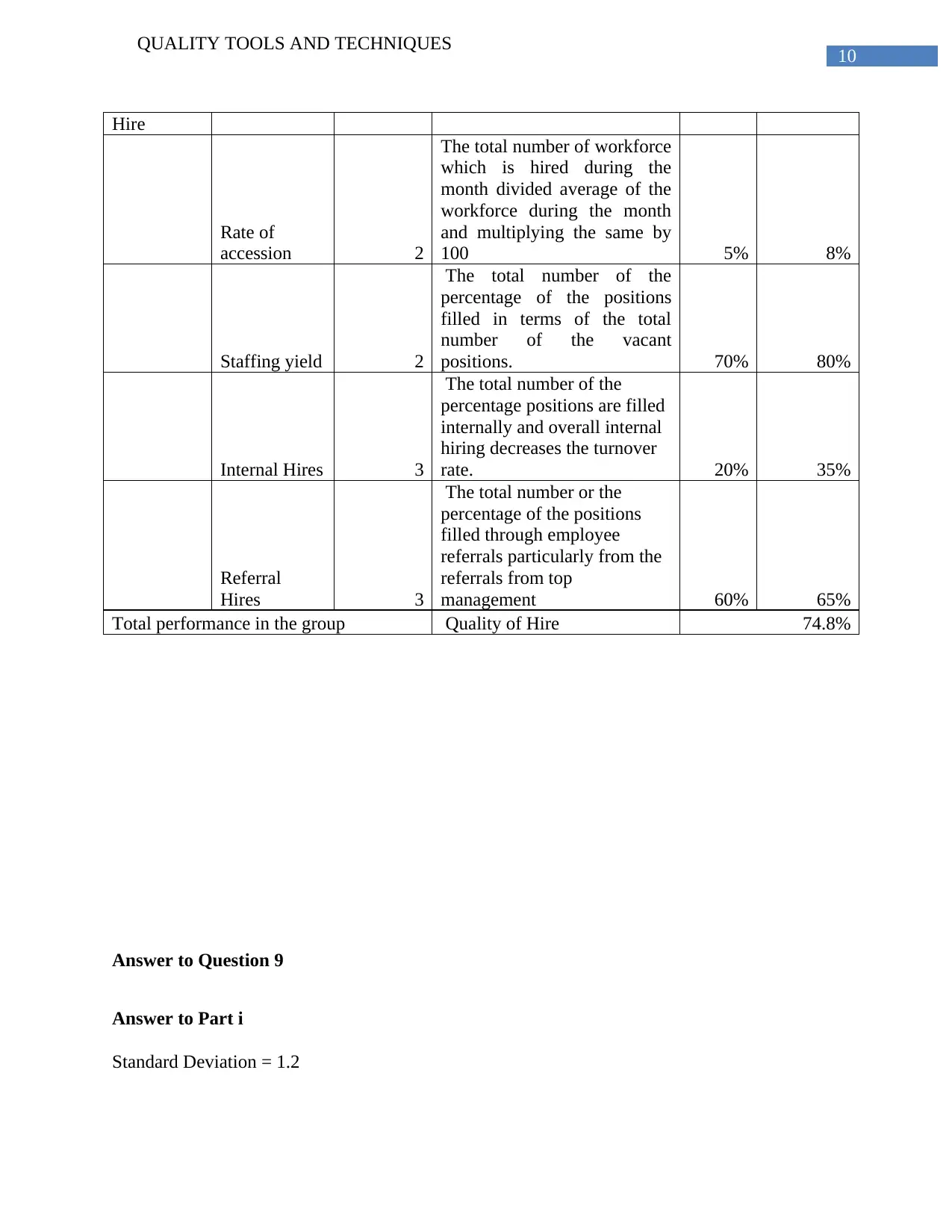
10
QUALITY TOOLS AND TECHNIQUES
Hire
Rate of
accession 2
The total number of workforce
which is hired during the
month divided average of the
workforce during the month
and multiplying the same by
100 5% 8%
Staffing yield 2
The total number of the
percentage of the positions
filled in terms of the total
number of the vacant
positions. 70% 80%
Internal Hires 3
The total number of the
percentage positions are filled
internally and overall internal
hiring decreases the turnover
rate. 20% 35%
Referral
Hires 3
The total number or the
percentage of the positions
filled through employee
referrals particularly from the
referrals from top
management 60% 65%
Total performance in the group Quality of Hire 74.8%
Answer to Question 9
Answer to Part i
Standard Deviation = 1.2
QUALITY TOOLS AND TECHNIQUES
Hire
Rate of
accession 2
The total number of workforce
which is hired during the
month divided average of the
workforce during the month
and multiplying the same by
100 5% 8%
Staffing yield 2
The total number of the
percentage of the positions
filled in terms of the total
number of the vacant
positions. 70% 80%
Internal Hires 3
The total number of the
percentage positions are filled
internally and overall internal
hiring decreases the turnover
rate. 20% 35%
Referral
Hires 3
The total number or the
percentage of the positions
filled through employee
referrals particularly from the
referrals from top
management 60% 65%
Total performance in the group Quality of Hire 74.8%
Answer to Question 9
Answer to Part i
Standard Deviation = 1.2
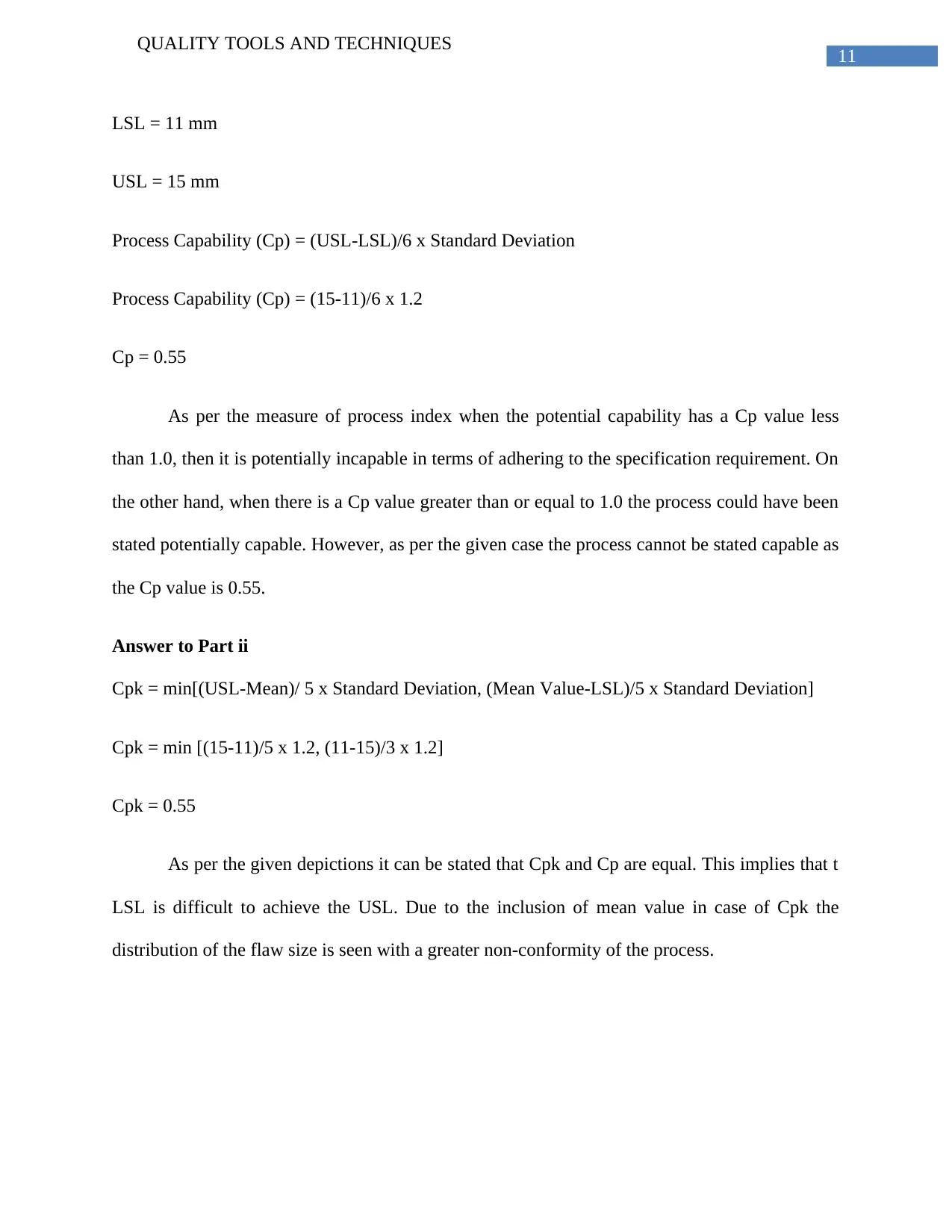
11
QUALITY TOOLS AND TECHNIQUES
LSL = 11 mm
USL = 15 mm
Process Capability (Cp) = (USL-LSL)/6 x Standard Deviation
Process Capability (Cp) = (15-11)/6 x 1.2
Cp = 0.55
As per the measure of process index when the potential capability has a Cp value less
than 1.0, then it is potentially incapable in terms of adhering to the specification requirement. On
the other hand, when there is a Cp value greater than or equal to 1.0 the process could have been
stated potentially capable. However, as per the given case the process cannot be stated capable as
the Cp value is 0.55.
Answer to Part ii
Cpk = min[(USL-Mean)/ 5 x Standard Deviation, (Mean Value-LSL)/5 x Standard Deviation]
Cpk = min [(15-11)/5 x 1.2, (11-15)/3 x 1.2]
Cpk = 0.55
As per the given depictions it can be stated that Cpk and Cp are equal. This implies that t
LSL is difficult to achieve the USL. Due to the inclusion of mean value in case of Cpk the
distribution of the flaw size is seen with a greater non-conformity of the process.
QUALITY TOOLS AND TECHNIQUES
LSL = 11 mm
USL = 15 mm
Process Capability (Cp) = (USL-LSL)/6 x Standard Deviation
Process Capability (Cp) = (15-11)/6 x 1.2
Cp = 0.55
As per the measure of process index when the potential capability has a Cp value less
than 1.0, then it is potentially incapable in terms of adhering to the specification requirement. On
the other hand, when there is a Cp value greater than or equal to 1.0 the process could have been
stated potentially capable. However, as per the given case the process cannot be stated capable as
the Cp value is 0.55.
Answer to Part ii
Cpk = min[(USL-Mean)/ 5 x Standard Deviation, (Mean Value-LSL)/5 x Standard Deviation]
Cpk = min [(15-11)/5 x 1.2, (11-15)/3 x 1.2]
Cpk = 0.55
As per the given depictions it can be stated that Cpk and Cp are equal. This implies that t
LSL is difficult to achieve the USL. Due to the inclusion of mean value in case of Cpk the
distribution of the flaw size is seen with a greater non-conformity of the process.
⊘ This is a preview!⊘
Do you want full access?
Subscribe today to unlock all pages.

Trusted by 1+ million students worldwide
1 out of 13
Related Documents
Your All-in-One AI-Powered Toolkit for Academic Success.
+13062052269
info@desklib.com
Available 24*7 on WhatsApp / Email
![[object Object]](/_next/static/media/star-bottom.7253800d.svg)
Unlock your academic potential
Copyright © 2020–2025 A2Z Services. All Rights Reserved. Developed and managed by ZUCOL.





